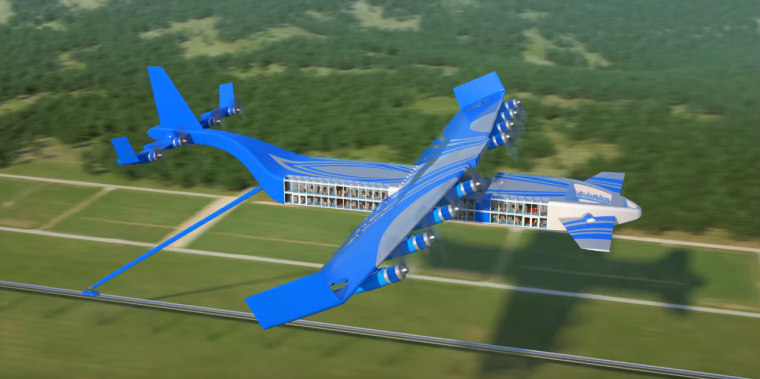From room-size vehicles that drive over traffic jams to firefighting drones that lift firefighters high above crowded city streets, Dahir Semenov has proposed all kinds of strange, futuristic vehicles and urban systems. Now the Russian engineer is offering up his vision for a high-speed passenger train that would fly between stations rather than ride between them on rails.
A new computer-animated video shows several versions of the proposed flying train, each capable of carrying hundreds of passengers and featuring tilting wings and electrically powered propellers. The electricity needed to propel the flying train would be fed through a moving tether linked to an electrified rail that runs on the ground from station to station.
Flying trains would offer an alternative to conventional trains and even commercial airliners for cross-country journeys, Semenov told NBC News MACH in an email. Though not as fast as an airliner, the proposed train would be much faster than conventional trains, he said. Amtrak’s fastest trains top out at about 150 miles per hour, and even the world's fastest trains have top speeds well below 300 mph. Semenov said his proposed flying train would be able to go more than 400 mph.
Semenov has been likened to Buckminster Fuller, the prolific 20th-century American designer whose ideas ranged from three-wheeled flying cars to floating cities. But some experts think the idea of a flying train may be a bit off the rails.
“Many transportation dreams from the past have never been realized — such as Fritz Lang’s futuristic cityscape for his groundbreaking 1927 film, 'Metropolis,' and his aerial monorails and compact flying vehicles,” Carlo Ratti, director of MIT’s Senseable City Lab and an expert on the future of transportation, said in an email. It might be hard to integrate flying trains into existing transportation networks, he said, adding that the flying train's top speed sounded optimistic.
Norman Garrick, a University of Connecticut engineering professor who specializes in sustainable transportation and urban planning, said future advances in transportation will likely depend less on radical new vehicles than on new ways to use existing ones — such as car- and bike-sharing programs and now electric scooter sharing.
“A lot of what is needed is not about necessarily new objects because we have a lot of objects that work," Garrick said. "It is a matter of how we manage those kinds of things.”
But Semenov seems to be moving forward with his idea. According to a statement by Dahir Insaat, his Istanbul, Turkey-based engineering firm, he's refining the flying train design and is on the lookout for investors.

